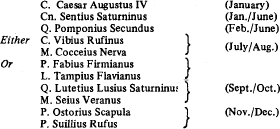Article contents
The Fasti for the Reign of Gaius*
Published online by Cambridge University Press: 08 May 2015
Extract
The consular fasti for the first two years of the reign of Gaius have their full complement of consuls. Degrassi lists them as follows:
37* Cn. Acerronius Proculus, C. Petronius Pontius Nigrinus
k. Iul. C. Caesar Augustus Germanicus, Ti. Claudius Nero Germamicus
k. Sept. A. Caecina Paetus, C. Caninius Rebilus
38* M. Aquila Iulianus, P. Nonius Asprenas
k. Iul. Ser. Asinius Celer, Sex. Nonius Quintilianus (Quinctilianus)
The most noteworthy feature about these years is that in 37 there is a change in the normal pattern for allocating consulships within each year. This pattern had been established by August in 5 B.C. In those years in which an ordinarius left office before the end of the year, he did so at the end of June and was replaced by a suffectus on the first day of July who remained in office for the remainder of the year. However since the year 37 saw the beginning of a new reign, the change is not difficult to explain. It is also noteworthy that Gaius and his uncle Claudius took office for only two months and then allowed A. Caecina Paetus and C. Caninius Rebilus to assume the consulships for which they had been designated. The year 38 shows a return to the regular pattern.
- Type
- Research Article
- Information
- Copyright
- Copyright © Australasian Society for Classical Studies 1979
References
1 Degrassi, A., I fasti consolari dell’Impero Romano (Roma 1952), 10 f.Google Scholar An asterisk indicates that all consuls are known for the year in question.
2 Ibid. 5 f.; Ehrenberg, V., and Jones, A.H.M.Documents illustrating the Reigns of Augustus and Tiberius (Oxford 1955), 38 f.Google Scholar
3 Giordano, C., ‘Nuove tavolette cerate pompeiane’, Rend. Acc. Lett, e Belle Arti di Napoli 45 (1970), 218 f. no.6;Google Scholar ‘Nuove tavolette cerate pompeiane’, ibid. 46 (1971), 196 f. = AE 1973, 138. See also Barbieri, G., ‘A. Didius Gallus e Ti. Iulius Iulianus’, RAL 29 (1974), 259Google Scholar and Eck, W., RE Suppl. 14. 111.Google Scholar
4 Dio 59. 20. 1–3.
5 Sbordone, F., ‘Preambolo per l’edizione critica delle tavolette cerate di Pompeii’, Rend. Acc. Lett, e Belle Arti di Napoli 51 (1976), 145 f.Google Scholar no. 1, revisingGiordano, C., ‘Nuove tavolette cerate pompeiane’, ibid. 46 (1971), 195 f.Google Scholar
6 F. Sbordone 166 no.17.
7 Gallivan, P.A., ‘The First Consulship of L. Tampius Flavianus Again’, Historia forthcoming;Google Scholar cf. my paper ‘The Fasti for the Reign of Claudius’, CQ 28 (1978), 407–26 (= Gallivan 1978), at 417 f.
8 Rufinus and Nerva are attested in office on 5 August (ILS 795) and Firmianus is known to have been consul with Flavianus on 5 August of another year (C. Giordano [op cit. n.5] 191 f. = AE 1973, 162 with Eck, W., ‘Erganzungen zu den Fasti consulares des 1 und 2 Jh. n. Chr.’, Historia 24 [1975], 339).Google Scholar The assumption that a minimum period of two months was usual for the tenure of a suffect consulship after the year 39 is based on the fact that this period was the minimum length of tenure under both Claudius (see Gallivan 1978, 407 f.) and Nero (see Gallivan, P.A., ‘Some Comments on the Fasti for the Reign of Nero’, CQ 24 [1974], 290 f.)CrossRefGoogle Scholar. Certainly Gaius and Claudius remained in office for only two months in 37.
9 I have already shown that the fasti for 41 are now complete (see Gallivan 1978, 424). The consuls were:

10 So also Degrassi (op. cit. n.l) 12. Further on Vinicianus, see PIR 2 A 701 and Swan, M., ‘Josephus AJ 19, 215–252: Opposition to Gaius and Claudius’, AJPh 91 (1970), 150 f.Google Scholar
11 Κλούιτος is the name found in the manuscript of Josephus but Hudson suggested Κλούβιου, i.e. Cluvius. The reading is accepted by L.H. Feldman in the Loeb edition. (In general on the problem of Roman names in Josephus, see Swan 153.) Given that Hudson's reading is correct, Cluvius should probably not be identified with the historian Cluvius Rufus (see further Syme, R., Tacitus [Oxford 1958], 293 f.;Google ScholarAlfòldy, G., Fasti Hispanienses [Wiesbaden 1969], 16 f.).Google Scholar He may be the father of the historian as suggested by Groag (PIR 2 C 1202).
12 CIL 6. 1496 = Inscr. Italiae 13. 1. 306.
13 For his governorship in 37, ILS 190. Syme, R., ‘The Ummidii’, Historia 17 (1968), 74,Google Scholar suggests that he may have been in Lusitania from 31–37; G. Alföldy, 136, more cautiously dates his tenure to sometime within the period 31–39.
14 For detailed discussion, see Gallivan 1978, 419 n.58. The list includes Didius Gallus, A., cos. suff. 39;Google ScholarDomitius Afer, Cn., cos. suff. 39;Google Scholar Sex Palpellius Hister cos. suff. 43 and Curtius Rufus, Q., cos. suff. 43.Google Scholar
15 The date of this inscription must fall at some time after 38 but it is not clear when. See further Degrassi, A., ‘Osservazioni su alcuni consoli suffetti dell’età di Augusto e Tiberio’, Epigraphica 8 (1946), 38 f.Google Scholar
16 Balbus was legate of Syria in 49/50 (CIG 4697b = 4529 with Add. 1175). Cf. Gallivan 1978,421.
17 Anteius Rufus is the least likely of the four candidates since he was governor of Dalmatia certainly in 51/52 (PIR 2 A 731) and very probably governed the province during the period 50–54 (so Wilkes, J., Dalmatia [London 1969], 444).Google Scholar
18 I give Gaius’ years of tribunician power in brackets.
19 There can be no doubt, given the likelihood that C. Ummidius Durmius Quadratus should be included in the fasti for 39 or 40, that a third pair of suffects held office in this year.
20 The following dates were established in Gallivan 1978, 426.
- 6
- Cited by




